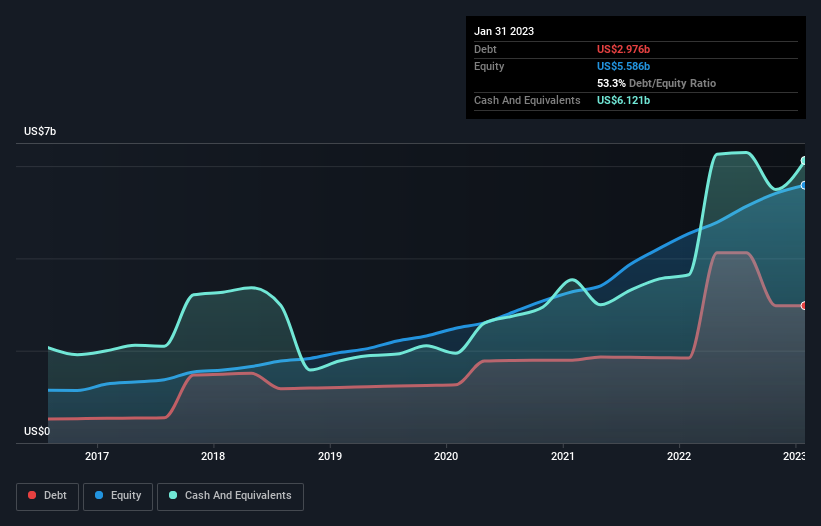Is Workday (NASDAQ:WDAY) A Risky Investment?
David Iben put it well when he said, 'Volatility is not a risk we care about. What we care about is avoiding the permanent loss of capital.' So it might be obvious that you need to consider debt, when you think about how risky any given stock is, because too much debt can sink a company. Importantly, Workday, Inc. (NASDAQ:WDAY) does carry debt. But should shareholders be worried about its use of debt?
What Risk Does Debt Bring?
Debt assists a business until the business has trouble paying it off, either with new capital or with free cash flow. If things get really bad, the lenders can take control of the business. While that is not too common, we often do see indebted companies permanently diluting shareholders because lenders force them to raise capital at a distressed price. Of course, the upside of debt is that it often represents cheap capital, especially when it replaces dilution in a company with the ability to reinvest at high rates of return. When we examine debt levels, we first consider both cash and debt levels, together.
See our latest analysis for Workday
What Is Workday's Net Debt?
The image below, which you can click on for greater detail, shows that at January 2023 Workday had debt of US$2.98b, up from US$1.84b in one year. But on the other hand it also has US$6.12b in cash, leading to a US$3.15b net cash position.
A Look At Workday's Liabilities
We can see from the most recent balance sheet that Workday had liabilities of US$4.63b falling due within a year, and liabilities of US$3.27b due beyond that. Offsetting these obligations, it had cash of US$6.12b as well as receivables valued at US$1.57b due within 12 months. So its liabilities total US$209.2m more than the combination of its cash and short-term receivables.
Having regard to Workday's size, it seems that its liquid assets are well balanced with its total liabilities. So it's very unlikely that the US$48.2b company is short on cash, but still worth keeping an eye on the balance sheet. While it does have liabilities worth noting, Workday also has more cash than debt, so we're pretty confident it can manage its debt safely. The balance sheet is clearly the area to focus on when you are analysing debt. But ultimately the future profitability of the business will decide if Workday can strengthen its balance sheet over time. So if you're focused on the future you can check out this free report showing analyst profit forecasts.
Over 12 months, Workday reported revenue of US$6.2b, which is a gain of 21%, although it did not report any earnings before interest and tax. Shareholders probably have their fingers crossed that it can grow its way to profits.
So How Risky Is Workday?
Although Workday had an earnings before interest and tax (EBIT) loss over the last twelve months, it generated positive free cash flow of US$1.3b. So although it is loss-making, it doesn't seem to have too much near-term balance sheet risk, keeping in mind the net cash. One positive is that Workday is growing revenue apace, which makes it easier to sell a growth story and raise capital if need be. But that doesn't change our opinion that the stock is risky. There's no doubt that we learn most about debt from the balance sheet. However, not all investment risk resides within the balance sheet - far from it. To that end, you should be aware of the 2 warning signs we've spotted with Workday .
If, after all that, you're more interested in a fast growing company with a rock-solid balance sheet, then check out our list of net cash growth stocks without delay.
Have feedback on this article? Concerned about the content? Get in touch with us directly. Alternatively, email editorial-team (at) simplywallst.com.
This article by Simply Wall St is general in nature. We provide commentary based on historical data and analyst forecasts only using an unbiased methodology and our articles are not intended to be financial advice. It does not constitute a recommendation to buy or sell any stock, and does not take account of your objectives, or your financial situation. We aim to bring you long-term focused analysis driven by fundamental data. Note that our analysis may not factor in the latest price-sensitive company announcements or qualitative material. Simply Wall St has no position in any stocks mentioned.
Join A Paid User Research Session
You’ll receive a US$30 Amazon Gift card for 1 hour of your time while helping us build better investing tools for the individual investors like yourself. Sign up here

